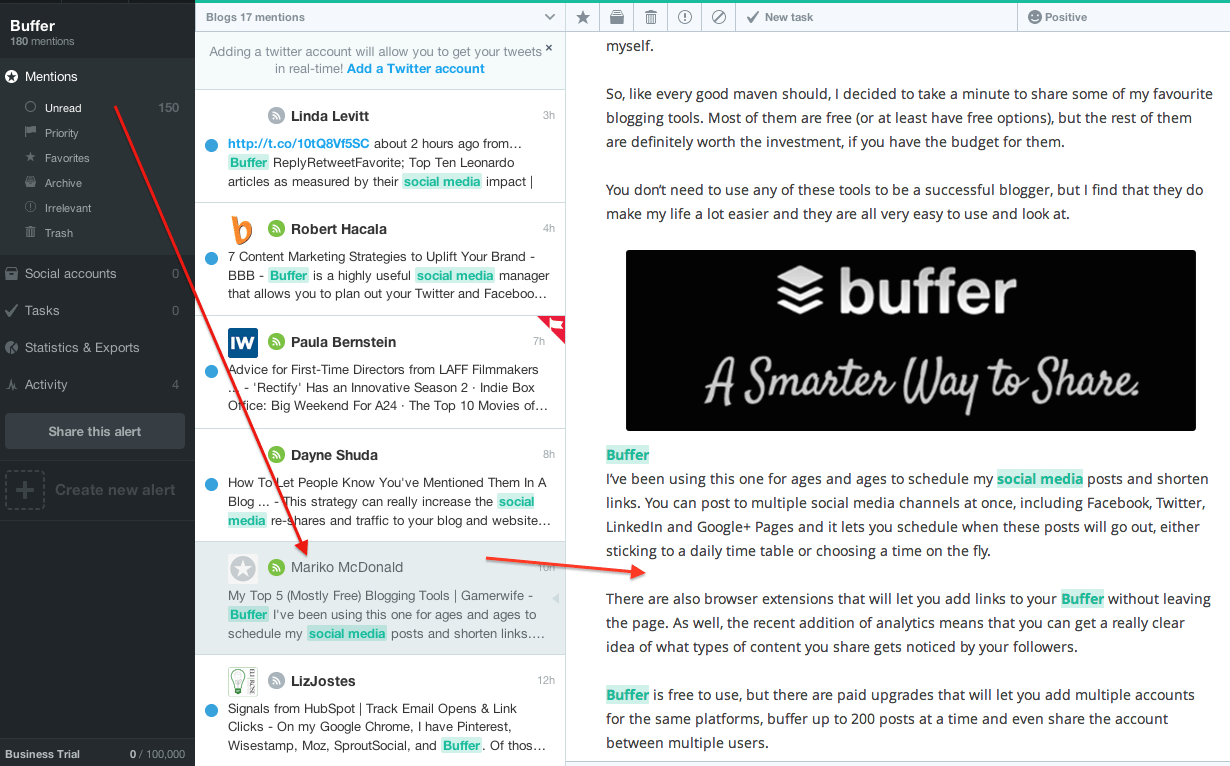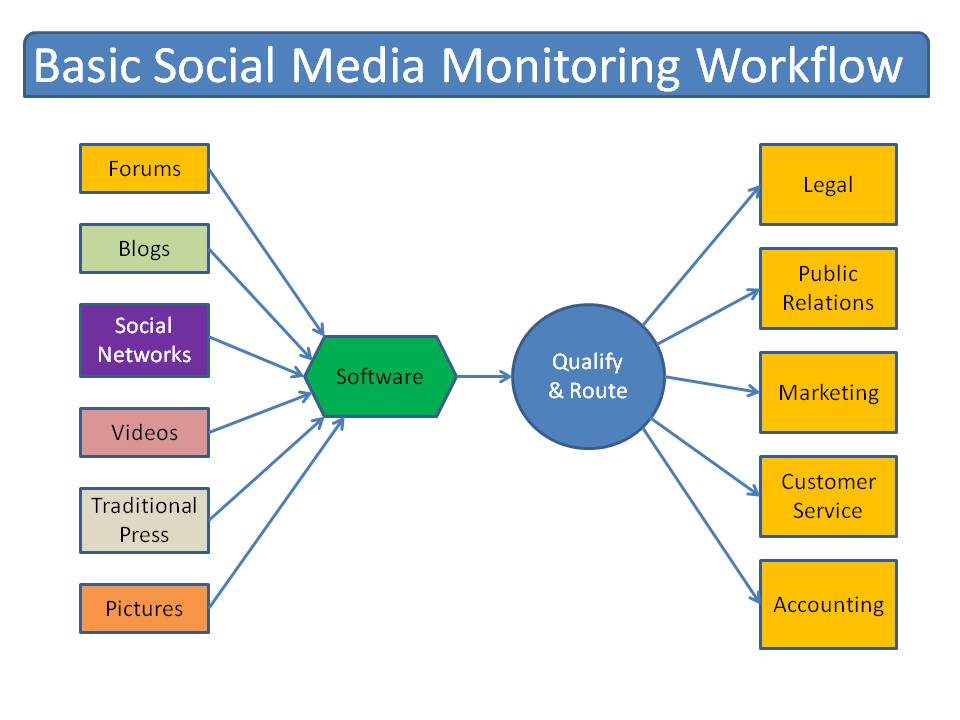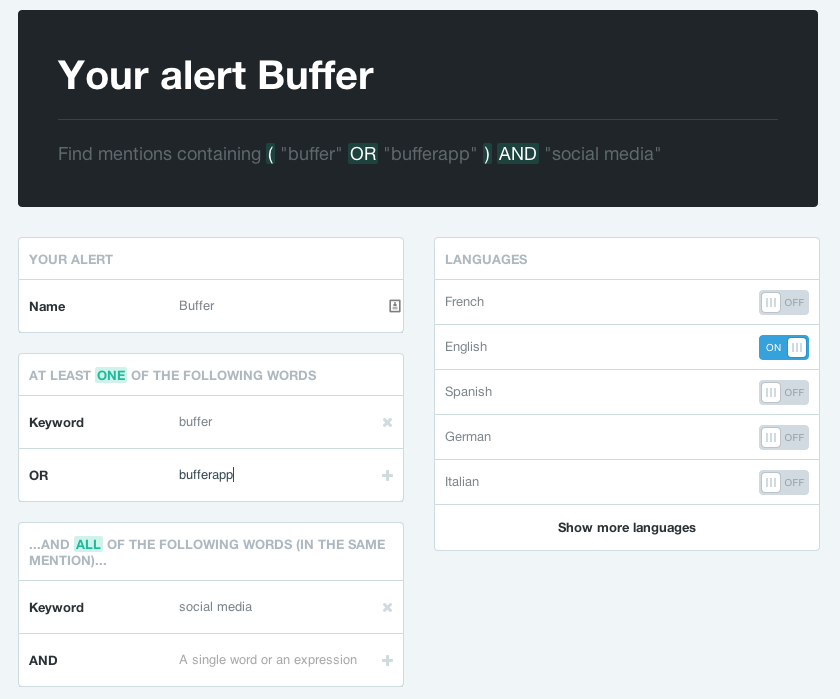One of the most fascinating things about social media is its ability to clue you in to things that you might otherwise have had no idea even existed—there are tons of conversations, communities, articles and so much more just waiting to be discovered online.
The trick is: How do you find all of the information online that’s relevant to you and your interests and bring it back in such a way that you can make use of it all?
The answer, for many brands and individuals, is social media monitoring. With the tools and strategies of basic social media monitoring, you can always keep an eye on whatever’s important to you, wherever it is on the web.
Social media monitoring—sometimes also referred to as social media listening—is more than simply responding when you’re mentioned online. The best social media monitoring strategies not only help surface conversations but also help you understand them more deeply so you know how best to use the knowledge you gain.
You might use social media monitoring for many different reasons—to find great content to curate for your audience, to keep an eye on your competitors or other folks in your space, to provide amazing customer service, to look for opportunities to grow and improve your products or service, or maybe all of these!
For all the benefits and opportunities social media monitoring provides, it’s a surprisingly small investment of time and energy. You don’t have to spend hours a day to get all the benefits. All you need is the right plan in place – and a few tools to make sure everything you want to see is coming in, with all the noise filtered out. Here’s a quick guide to help you get started reaping all the benefits of social media monitoring.
Step 1: What to monitor?
The first step is to know what’s worthwhile to monitor and what types of searches will net you the best results. It might take a bit of trial and error, but here are some ideas of where you might want to begin.
Brand or company monitoring
- Your name or your brand’s name
- Any variations of your brand’s name (For example, I would want to monitor both “Buffer” and “Bufferapp” for my brand)
- Potential misspellings of your brand’s name
- Names of the most active/visible members of your company
- Mentions of specific campaigns you’re running
- Your catchphrase, slogan or tagline
Industry or topic monitoring
- Key words or phrases that describe your industry or interest (For example, at Buffer I might want to monitor for key phrases like “social media sharing,” “social media posting” and “social media automation” to start out)
- Key words or phrases related to or complementary to your industry or interest
- Frequently used industry hashtags
Step 2: How to monitor? Choose your tools
Once you’ve got an idea of why you’re entering social media monitoring and what you want to monitor, you’ll want to enter your searches into a tool that can keep an eye on your queries for you and serve up the results. There are tons of social media monitoring tools out there – here’s a giant wiki of lots of them. For our purposes today, we’ll focus on free tools, including:
Google Alerts mention Social Mention TalkwalkerMost of these tools work somewhat similarly by allowing you to enter the exact phrase you want, plus any related words or minus any phrases you don’t want. Once you check out the results, you’ll likely see a way to have alerts periodically sent to your email inbox. Here’s a look at a search I built with mention (which, by the way, integrates beautifully with Buffer):
For bigger organizations that need a full-service social care solution, options include tools like Buffer favorite SparkCentral, as well as Salesforce Social Hub, Zendesk, Freshdesk and more.
There’s plenty you can do with the tools you’re likely already using, too. Even subscribing to your competitors’ blogs in Feedly could be considered a form of social media monitoring.
With Twitter alone, there are a ton of ways to get insights and intelligence from a few simple lists and searches. Here are a few ideas:
- Create and save Twitter searches focusing on major industry terms and hashtags
- Monitor hashtags for conferences happening in your industry.
- Create Twitter lists of major influencers and news sources in your industry.
- Create Twitter lists focusing on specific industry topics.
- Create a Twitter list of advocates and fans of your product.
- Monitor industry-related Twitter chats for questions or potential ideas.
I bet you can think of lots more for Facebook, Google+ LinkedIn, Quora and others.
Step 3: What are you looking for? Find insights in your results
The beauty of social media monitoring is that there’s really no telling what you’re going to find each day. It’s kind of like fishing—you just have to see what’s biting that day.
But generally, the most useful result you can uncover from your monitoring effort is an opportunity. These opportunities can take many forms—it could be a chance to create a new piece of content, build a new relationship or even change your product or service to solve a common problem.
Here, for example, is a great relationship-building opportunity I discovered from my search with mention: A blogger who is kindly writing about her Buffer experience!

As you sort through your social media monitoring results, here are some results you might come across and the opportunities they might provide:
- Sentiment: Are people saying mostly positive or (gulp) mostly negative things about you? Do you see patterns by which you could improve this ratio? (Maybe that’s a metric you want to track month-over-month).
- Feedback: Feedback on your product or service is always useful, particularly the kind of feedback you can hear by listening to casual, back-and-forth conversations on Twitter. You don’t have to step in with a response right away; the listening is what’s important here.
- Questions: Are you seeing the same frequently asked questions about your brand or industry? Maybe there’s an opportunity to create a piece of content that can help answer these questions.
- Links: Keeping track of who’s linking to you and how can be really useful for search engine optimization campaigns.
- Language: If your brand is being mentioned in different language than the one you’re writing in, it could be a sign it might be worthwhile to translate some of your content or consider multi-language customer service.
- Pain points: Are multiple customers having the same problems with your product? Maybe that’s an opportunity to make a change, or alter the way you provide customer service. Are multiple people complaining about the same industry-wide problem? Sounds like a great opportunity for a problem-solving resource, or at least an epic rant blog post!
- Content: Social media monitoring is a great way to find all sorts of content—content you can share with your audience, learn from or build upon with your own creativity. Are you seeing the same content types and content topics shared again and again? That’s a good sign your content might need to focus on those types and topics.
- Trends: If you sell fireworks in the U.S., you know summer is going to be your moment on the public’s radar. Other brands might also have seasonal or even weekly trends (like the way Rebecca Black’s “Friday” video gets a weekly bump in traffic every… you guessed it … Friday!)
- Advocates: There’s nothing better than discovering brand advocates who want to talk about you, get to know you and spread the word about how great you are. Use social media monitoring to find and nurture your community of fans.
- Press opportunities: Know who’s on social media a lot? Journalists! Monitoring (maybe with a private Twitter list?) can help you get a read on what journalists in your industry are working on, what questions they have that you can answer and what they like and dislike when it comes to being pitched.
- Influencers: Close monitoring could help you discover someone in your industry whose voice resonates a little louder than most. What is that person creating or doing or writing that you can learn from? Is it someone you’d like to get to know?
Here’s a quick wrapup of some of the insights I find most useful to mine for when practicing social media monitoring:

Step 4: What next? Refine and communicate
Once you begin to see the results of your social media monitoring, you’ll probably want to refine your searches a bit to hone in on better results. Don’t be afraid to experiment with adding and subtracting words from your searches to make them ever more focused and efficient.
All that’s left to do now is synthesize this great pipeline of information you’ve created and find all the ways you can begin to act on the results you’re seeing. As you do so, make sure the information keeps flowing. If you’re on your own or at a small company, it should be easy enough to share and act on what you’ve learned so you can keep getting better.
Larger companies might need a more structured workflow, like this one visualized by SocialMediaHQ.

From there, you can get as creative as you like to keep learning and discovering more. Here are a few final thoughts; see if they spark any ideas for you:
- Create alerts for your brand name plus words like “love” or “great” to find more positive mentions. Maybe you can reach out to your fans with a little token of your appreciation? (At Buffer, we try to surprise some of our fans with these awesome Stickermule stickers.)
- Add qualifying words like “anyone,” “recommend” or “suggest” to industry phrase searches to find people who might be searching for a product like yours.
- Add specific terms like “infographic” to your topic searches to find unique types of shareable content to curate or link to on your own blog.
Now, over to you: How have you used social media monitoring to learn new things about your audience, content, product or community? I’d love to keep the conversation going in the comments!
P.S. If you liked this post, you might enjoy our Buffer Blog newsletter. Receive each new post delivered right to your inbox, plus our can’t-miss weekly email of the Internet’s best reads. Sign up here.
Try Buffer for free
190,000+ creators, small businesses, and marketers use Buffer to grow their audiences every month.




